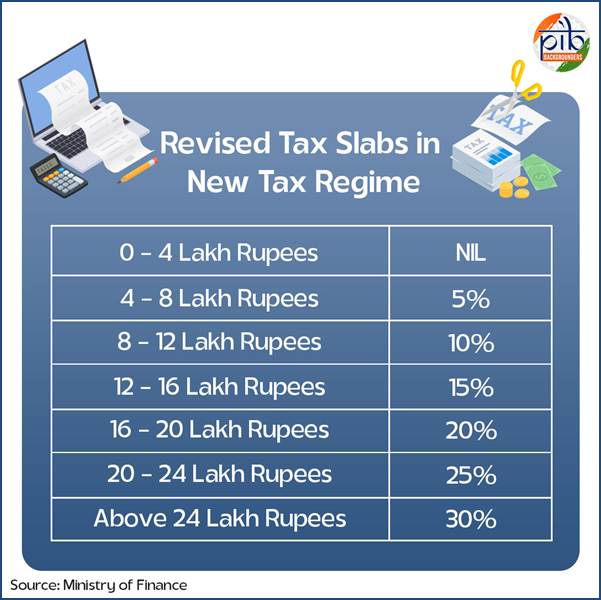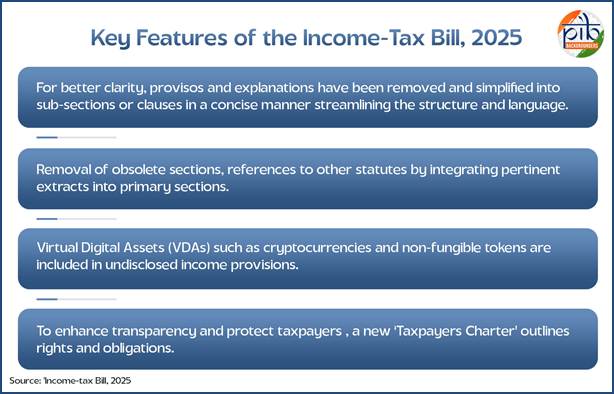Income Tax Bill 2025: A New Era in India’s Taxation Landscape
Introduction
The Income Tax Bill 2025, passed by the Indian Parliament, marks a historic overhaul of the country’s tax framework. Replacing the six-decade-old Income Tax Act of 1961, this legislation is designed to simplify tax laws, enhance compliance, and align India’s tax system with global best practices. Effective from April 1, 2026, the new bill introduces streamlined provisions, updated tax slabs, and modernized definitions—all aimed at making taxation more transparent and taxpayer-friendly.
What is the Income Tax Bill 2025?
- Purpose: Without altering tax rates, replace the Income-tax Act of 1961 with a more straightforward, readable law. Clarity, uniformity, and the elimination of superfluous clauses are the main goals.
- Status: The new bill has been passed by Parliament. A revised Income-tax (No. 2) Bill, 2025 was proposed and approved by both Houses in mid-August after the prior February version was withdrawn.
- When to apply: According to media reports, it is expected to begin on April 1, 2026. Keep an eye out for the announced start date.
What is the Implementation Timeline of The Income Tax Bill 2025?
| Milestone | Date |
|---|---|
| Bill Introduced in Lok Sabha | 13 February, 2025 |
| Passed by Parliament | 8 August, 2025 |
| Effective Date | 1 April, 2026 |
Why is the Income Tax Bill 2025 needed?
India’s previous tax law, the Income Tax Act of 1961, had grown unwieldy over the years:
- Over 819 sections and 47 chapters made it complex for taxpayers and professionals alike.
- Archaic language and outdated provisions created confusion and litigation.
- The rise of digital income, global investments, and new financial instruments demanded a modern legal framework.
- A thorough rewriting was started by the government in response to these issues, and the Income Tax Bill 2025, which halved the law’s word count from 5.12 lakh to 2.6 lakh words and reduced it to 536 parts and 23 chapters
What are the Features of the Income Tax Bill 2025?
- Simplified Tax Slabs
- Full exemption for income up to ₹4 lakh
- Reduced rates for income between ₹4 lakh and ₹12 lakh (5% to 15%).
- Tax burden reduction through marginal relief for income beyond ₹12 lakh
- Enhanced Rebates
- Old regime: 100% of income up to ₹5 lakh (up to ₹12,500) is refunded.
- New regime: 100% of income up to ₹12 lakh (up to ₹60,000) is refunded.
- Clarity on Property Income
- Real rent or notional value, whichever is larger, is now considered taxable income.
- Company-use properties are taxed as company income rather than property income.
- Interest paid on loans taken out for home improvement or acquisition is deductible.
- Pension and Retirement Benefits
- The pension corpus is exempt from taxes at retirement up to 60% of the time.
- The remaining 40% that was utilized to buy an annuity is taxable.
- Under Sections 80CCD(1) and 80CCD(2), employer and employee contributions are still eligible for deductions.
- Corporate Tax Adjustments
- Section 80M dividend deductions between corporations have been restored.
- For LLPs, the Alternate Minimum Tax (AMT) is modified to prevent higher taxes.
- Restoring tax incentives for non-profits and charity trusts permits capital gains to be reinvested.
- Digital Compliance and Data Protection
- The bill grants income tax authorities powers during digital surveys and searches.
- Email servers
- Social media accounts
What are the Aims of the Income Tax Bill 2025?
- Simplify the law’s text and structure: Reducing legalese, restructuring chapters, and simplifying the Act are the government’s declared objectives. In order for taxpayers to map previous sections to the new clauses, it also contains navigators and frequently asked questions. This is not about surprises, but about assurance and readability.
- Keep rates unchanged: The government has said unequivocally that rate changes are not the purpose of the exercise. This provides stability when the wording and layout are changed.
- Implement most Select Committee suggestions: The updated Bill includes almost all of the Select Committee’s recommendations, according to economic policy coverage. For this reason, the original bill was pulled and reintroduced as the second bill.
- Replace the 1961 Act after six decades: With Parliament’s approval, the lengthy 1961 framework—which had undergone numerous revisions—will finally be replaced. The new law should be clear and logical from the start.
What are the Big structural highlights inside the new law Income Tax Bill 2025?
- A cleaner chapter layout and familiar heads of income
- The five revenue sources you are already familiar with—salaries, real estate, company or occupation, capital gains, and other sources—are retained in the new text, but they are presented in a far more structured manner.
- Clearer treatment of unexplained items
- Chargeability is intimately linked to the Bill’s provisions on unexplained credits, investments, assets, and expenditures. This makes it easier to see what is taxed when records don’t add up.
- Consolidated loss set-off and carry-forward rules
- With uniform definitions, the rules for set-off and carry-forward under various headings, speculation, specified business, and reorganizations are all in one location. This should make it easier for taxpayers to plan ahead and keep track of their losses.
- Deductions presented in one logical flow
- With cross-references to schedules and conditions, common deductions such as insurance premiums, health insurance, education loan interest, housing loan interest, gifts, and deductions relating to disabilities appear in a neat sequence.
- Cross-reference tools for transition
- The Income Tax Department has made FAQs and a Navigator available to assist in comparing new clauses with older ones. During the first filing season under the new law, this is helpful.
Conclusion
A historic reform that aims to change India’s tax system is the Income Tax Bill, 2025. By simplifying language, restructuring provisions, and introducing taxpayer-friendly measures, it aims to reduce compliance burdens and foster economic growth. Even while there are still issues, particularly with litigation and the clarity of deductions, the bill lays the groundwork for a more open and just tax system. Businesses, professionals, and taxpayers must remain aware and adjust to the new framework as India gets ready for its implementation in April 2026. India’s tax system will be more inclusive, intelligent, and leaner in the future.
Frequently Asked Questions (FAQs)
Has Parliament passed the new income tax law?
Yes. On August 11, 2025, the Lok Sabha and Rajya Sabha enacted the Income-tax (No. 2) Bill, 2025.
Are my tax rates changing because of this law?
No. Simplifying rather than changing rates is the government’s stated guiding concept for this operation. Any rate adjustments in the future would require separate Finance Acts.
When will I start filing under the new law?
According to media estimates, the expected start date is April 1, 2026. Await the formal notification of the beginning.
Does this change the heads of income or basic computation?
No. The structure used to calculate total income is still the same, but more straightforward, and the heads of income are unchanged.
Why was there a second Bill in August?
The February first bill was dropped following committee scrutiny. In August, the revised version was reintroduced and approved.
Sources:
- https://incometaxindia.gov.in/Pages/income-tax-bill-2025.aspx
- https://prsindia.org/files/bills_acts/bills_parliament/2025/The_Income-tax_Bill,_2025.pdf
- https://www.indiabudget.gov.in/doc/Finance_Bill.pdf
- https://indianexpress.com/article/explained/explained-economics/new-income-tax-bill-passed-in-parliament-key-features-10186767/
- https://www.pib.gov.in/PressNoteDetails.aspx?NoteId=154926&ModuleId=3
- https://www.incometax.gov.in/iec/foportal/help/individual/return-applicable-1
- https://www.thehindu.com/news/national/parliament-passes-new-income-tax-bill-to-replace-six-decade-old-law/article69926051.ece
- https://en.wikipedia.org/wiki/Income-tax_Act,_2025


Leave a Reply